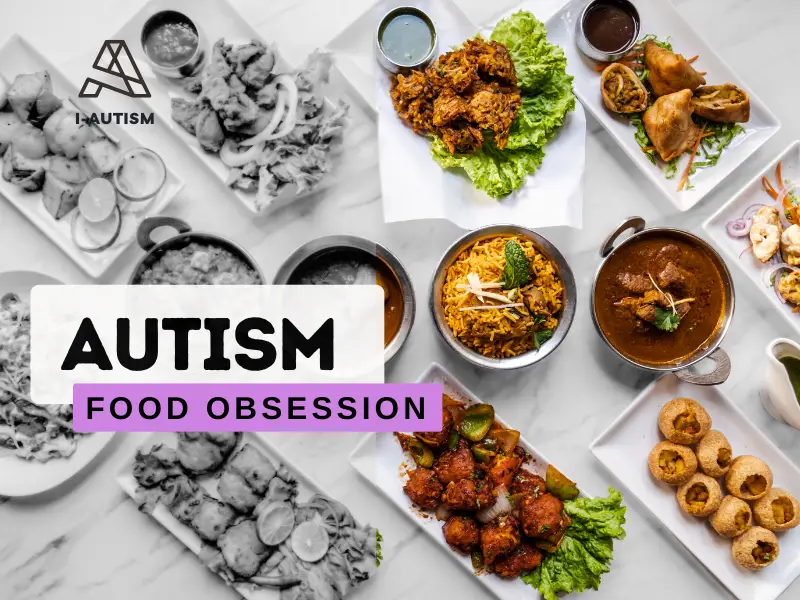Food is not just nourishment—it’s also tied to culture, emotion, and behavior. For individuals with autism, the relationship with food can be especially complex. One behavior that raises concerns for many caregivers and professionals is food obsession. This article explores the connection between autism and food obsession, offering practical insights, research-based explanations, and supportive strategies for caregivers and individuals.
What Is Food Obsession in Autism?
Food obsession refers to an intense preoccupation with certain types of food, routines around eating, or the act of eating itself. While everyone can develop food preferences, in individuals with autism, these patterns may become rigid or excessive.
Common Signs of Food Obsession in Autism:
Before diving into the reasons behind food obsession, it’s important to recognize the behaviors that may signal a concern:
- Extreme preference for specific foods, sometimes to the exclusion of all others
- Anxiety or distress when preferred foods are not available
- Excessive talking or thinking about food
- Repetitive behaviors involving food or mealtime
- Hoarding or sneaking food, even when not hungry
Why Does Food Obsession Occur in Autism?
Understanding the root causes of food obsession in autism requires a multifactorial lens. Several interconnected reasons may explain this behavior:
1. Sensory Processing Differences
Many individuals with autism experience heightened or reduced sensitivity to taste, texture, smell, and temperature.
- Some may find comfort in certain textures (e.g., crunchy or smooth)
- Others may avoid strong flavors or smells, narrowing food choices
- A predictable food may offer sensory comfort
2. Routines and Rigidity
Repetitive behaviors and strong preferences for routines are core characteristics of autism. Food routines can become rituals:
- Eating the same brand, shape, or color of food daily
- Following strict preparation methods
- Avoiding new or unfamiliar dishes
3. Anxiety and Control
Food can be a coping mechanism for dealing with anxiety or unpredictability in the environment.
- Preoccupation with food may serve as a form of control
- Obsession may increase during periods of stress or transition
4. Reward Systems and Dopamine
Research suggests that individuals with autism may experience differences in how their brains respond to rewards.
- Preferred foods may trigger a stronger dopamine response
- This could reinforce repetitive eating or craving behaviors
Diagnosing food obsession in individuals with autism involves a multidisciplinary assessment that goes beyond typical medical evaluations. Since food obsession can manifest in different ways—such as hoarding, fixating on specific foods, or experiencing distress when routines are disrupted—it’s important to gather detailed observations from caregivers, teachers, and therapists. Professionals typically assess behavioral patterns, sensory sensitivities, and emotional triggers through structured interviews and validated questionnaires. A psychologist or developmental pediatrician may use diagnostic tools like the Autism Diagnostic Observation Schedule (ADOS) in combination with behavioral assessments to identify obsessive tendencies around food. Collaborating with dietitians and occupational therapists can also help determine if the behavior stems from nutritional deficiencies, sensory processing issues, or anxiety-related coping strategies. Ultimately, diagnosis focuses on how food-related behaviors impact the individual’s daily functioning, health, and emotional well-being.
Risks and Consequences of Unchecked Food Obsession
While food obsession can be manageable, it can also lead to health and social challenges:
- Nutritional deficiencies or imbalances from limited diets
- Overeating or binge behavior
- Gastrointestinal issues
- Increased anxiety or behavioral meltdowns around food access
- Social isolation due to food-related rituals or stress
Supporting Healthy Food Relationships in Autism
Helping individuals with autism navigate food obsession involves a balance of structure, flexibility, and understanding. Caregivers and professionals can use the following strategies to encourage healthier patterns:
1. Gradual Food Exposure
Avoid abruptly introducing new foods, as this can trigger distress or resistance. Instead, implement food chaining techniques, which involve building a bridge from familiar, preferred foods to new options. This gradual approach respects the individual’s sensory sensitivities and provides a predictable, low-pressure pathway to dietary variety:
- Start with similar textures, colors, or temperatures
- Introduce new items alongside preferred ones
- Encourage visual, tactile, or olfactory exposure before tasting
2. Use Visual Supports
Visual aids can ease anxiety around food changes by providing structure and predictability during mealtimes. For individuals with autism who rely on routine and visual learning, tools like meal schedules, illustrated menus, or social stories can clarify expectations and reduce resistance. Countdown visuals can help prepare them for trying new foods, while visual recipes break down steps into manageable, less overwhelming chunks. These supports not only empower individuals with a sense of control but also foster gradual acceptance of new foods in a non-threatening way.
- Meal schedules and menu cards
- Countdown visuals for introducing new items
- Visual recipes and step-by-step preparation guides
3. Involve the Individual
When possible, empower the individual in food decisions by actively involving them in every stage of the process—from choosing meals and ingredients to participating in preparation and presentation. Offer limited but meaningful choices to support autonomy and reduce overwhelm. This approach not only enhances their sense of control and self-efficacy but also helps foster curiosity and willingness to try new foods. Over time, giving individuals a voice in food-related decisions can build a more positive and balanced relationship with eating.
- Offer limited choices that provide a sense of control while staying within dietary goals (e.g., “Would you like apple slices or grapes?”)
- Involve them in meal planning, letting them help pick meals for the week using visual menus or cookbooks
- Include them in simple food preparation tasks—washing vegetables, stirring ingredients, or setting the table—so they feel ownership
- Allow opportunities to explore new foods in a non-pressure context, such as through play-based food exploration or grocery store scavenger hunts
- Reinforce autonomy with positive feedback, emphasizing their role in making healthy, thoughtful choices limited choices (“Do you want carrots or cucumbers?”)
- Let them help with grocery shopping or simple food prep
- Reinforce non-food rewards and praise
4. Collaborate with Professionals
A multidisciplinary approach can help uncover underlying issues:
- Dietitian: for nutritional assessments and planning
- Occupational therapist: for sensory integration
- Behavioral therapist: for managing obsessive behavior
Food obsession in autism is complex but manageable. With patience, structure, and a compassionate approach, caregivers can help individuals build a more flexible and healthy relationship with food. Early intervention and collaboration with professionals are key to long-term well-being.
Caregivers are not alone—there’s a growing community of resources, support groups, and professionals ready to help.
FAQs: Autism and Food Obsession
- Is food obsession in autism common?
Yes, it’s relatively common due to sensory sensitivities and a preference for routine. - Can food obsession be dangerous?
It can lead to health issues like poor nutrition or overeating if not addressed. - What professionals should I consult?
A dietitian, occupational therapist, and behavioral therapist can help. - Is it okay to give in to food preferences?
Sometimes yes, but aim to gently broaden the diet for nutritional balance. - How can I make food changes less stressful?
Use visual supports, gradual exposure, and provide choices. - Can medication help with food obsession?
In rare cases and under medical supervision, medication may help manage anxiety or compulsive behavior. - What is food chaining?
A method of slowly introducing new foods based on similarities to accepted ones. - How can I track progress?
Use charts, visual aids, and notes to monitor what foods are accepted or rejected. - What if the obsession is with unhealthy foods?
Gradually introduce healthier alternatives that are similar in taste or texture. - Can adults with autism have food obsessions too?
Yes, food-related behaviors can persist or evolve over time.



